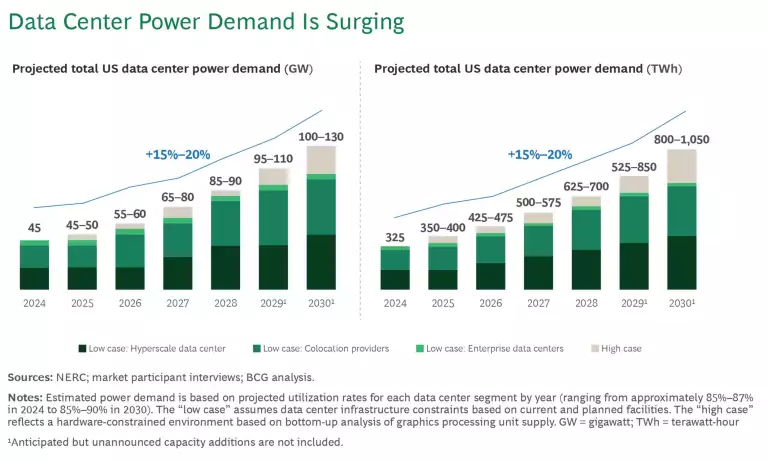AI is transforming the energy industry . The AI-fueled growth in power consumption will fundamentally alter energy demand and supply. At the same time, oil and gas companies can apply AI to boost performance by improving end-to-end operations, reducing costs, and managing the energy transition .
To navigate the challenges of the AI revolution, companies will need to enhance their agility. Because AI applications will eventually be as commonly available as standard software, speed and flexibility in the adoption of industry-specific and general business solutions will be more important than the technology itself in driving competitive advantage.
To improve capabilities fast enough to keep pace,
oil and gas companies
will need to reshape their DNA. This means devoting the lion’s share of their attention and resources to addressing people, processes, and culture as they accelerate the adoption of AI tools and data. Considering the industry’s traditional reliance on assets to achieve market leadership, strong change-management capabilities will be crucial for realizing AI’s competitive potential.
The Demand-and-Supply Implications Are Significant
The growing adoption of AI is expected to increase US electricity consumption by 15% to 20% annually through 2030, driven by the expansion of data centers . (See exhibit.) However, the current grid already faces challenges in balancing reliability standards with the need for lower-carbon energy. This underscores the trade-offs required among reliability, cost, and sustainability in powering AI infrastructure.

The choices made by data centers and technology companies for powering their operations will influence future electricity demand and heighten the focus on low-carbon baseload power, such as geothermal energy or carbon capture and sequestration (CCS) with natural gas. Consequently, oil and gas companies will need to reassess their portfolios and explore diversified roles in the electricity value chains.
In addition to increasing electricity consumption, AI is transforming operations in the energy sector. AI-driven improvements in quality and productivity will lead to lower production costs, lower carbon intensity per barrel produced, and higher efficiency. Cost efficiencies will emerge from better well designs, optimized production processes, and higher worker productivity. By the end of the decade, autonomous agents and AI-enabled robots may transform operational efficiency in energy production, lowering costs and emissions. These operational improvements and cost efficiencies can help companies to continue to invest in and manage the energy transition.
Bringing AI to the Oil Field
Since the arrival of generative AI (GenAI), many oil and gas companies have adopted third-party office productivity tools, such as solutions using “retrieval augmented generation” techniques (for example, Microsoft’s Copilot), to support tasks like corporate report writing.
Beyond office applications, oil and gas companies are applying AI to improve the quality and productivity of oil field operations and petro-tech disciplines. For example, they are using AI to support asset maintenance, such as by analyzing corrosion images and generating predictive alerts to help prevent issues before they arise. They are also testing the use of chatbot-like applications that offer real-time technical troubleshooting guidance to frontline technicians. In addition to streamlining daily operations, companies are investing in AI to support long-term objectives. For example, they are testing how AI can assist in advanced scientific analysis to improve the efficiencies of electrolyzers and carbon capture materials to support the use of hydrogen and CCS to lower emissions.
The most valuable enhancements will arise from using AI to promote major innovations. Drawing insights from other sectors, oil and gas companies can pursue breakthroughs that promote transformative changes in operations. For example, they can apply AI to emerging technologies, such as carbon sequestration, methane pyrolysis, and renewable fuels. Through AI, companies can gain the innovative edge needed to reach a new level of cost efficiency as they navigate the energy transition. The ultimate vision is to enable autonomous operations, including synthetic seismic data evaluations, AI-generated well designs, and AI-guided operations.
To achieve these ambitions, companies must build strong technical and data foundations. The drive to unlock AI’s full potential has sparked a renewed focus on data and digital platforms, particularly for breaking down data silos and establishing robust data foundations. Companies are shifting from reactively addressing use cases to proactively designing data maps to generate value through AI applications. This new approach will support applications for analyzing development plans, evaluating operation options, and forecasting markets for refined products.
In addition to improving data quality and integration, AI offers opportunities to transform energy companies’ ways of working and productivity. The challenge is to sustainably ensure that new technologies streamline workflows and drastically improve decision making.
Companies will also need to tackle the challenges of scaling and realizing value from AI and GenAI. A
BCG study
found that of the 98% of companies across industries that are at least experimenting with AI, only 26% have developed the necessary capabilities to move beyond proofs of concept and begin extracting value.
Achieving Business Impact Through AI
Taken together, the shifting demand-and-supply dynamics and AI-driven opportunities point to actions for oil and gas companies across the three phases of BCG’s “deploy, reshape, and invent” framework .
Deploy GenAI in everyday tasks.
The initial focus, over the next 12 months, should be integrating GenAI into daily activities. The leading software companies are adding GenAI features to enhance back-office functions, such as HR, finance, and IT. The early adoption of these third-party technologies is table stakes for realizing value from AI.
Companies should consider that GenAI not only increases workers’ productivity but also can broaden the range of tasks they can perform. An experiment led by the BCG Henderson Institute found that employees can use GenAI to complete tasks that are beyond their current capabilities. It also found that an engineering mindset—for example, breaking problems down into subcomponents—could be a key success factor for workers adapting to GenAI tools.
Reshape critical processes.
Oil and gas companies should implement AI and GenAI to improve the quality and productivity of critical processes. This includes, for example, applying AI in frontline maintenance and operations to transform the daily workflows of oil field personnel. It could also include reshaping workflows through the inclusion of AI in seismic analysis. Such investments should be considered over a medium- to long-term horizon for unlocking value.
Invent new business models.
Through the end of the decade, oil and gas companies should seek to develop new business models that shift the focus from assets to agility. This includes leveraging AI-enabled autonomous operations. Significant operational and capital efficiencies will reduce the cost and carbon intensity of delivering energy.
Rewiring the Organization for Agility
To realize value from AI across time horizons, oil and gas companies need to reshape their DNA to become faster and more agile in their adoption of the technology. Sustained competitive advantage can only be achieved by consistently being the first mover in both industry-specific solutions and general business solutions. To accomplish this, companies must focus on two critical areas.
Ensure access to high-quality data.
Companies must make data easily accessible across organizational silos. This requires significant investments to ensure that the data is cleaned, organized, and structured properly so it is available and ready to use whenever it is needed. Moreover, companies must continually invest to maintain seamless data integration across the organization.
Emphasize people, processes, and culture.
BCG’s 10/20/70 approach to AI implementation recommends that companies devote most of their attention and resources (approximately 70%) to addressing people, processes, and culture, while allocating relatively less to algorithms and models or data and architecture. For oil and gas companies, this starts with fostering a culture of experimentation that encourages innovation and calculated risk-taking. Upskilling workers rapidly is also crucial so that they can responsibly and effectively utilize GenAI and AI solutions in their daily tasks. Finally, to sustain AI adoption at scale, companies should set clear targets and measurable goals, supported by aligned metrics, accountable owners, and centralized progress tracking.
AI and GenAI applications are poised to revolutionize the oil and gas industry. Companies must be prepared to advance from deploying office-based tools to improving the productivity and quality of oil field operations and, ultimately, unlocking the value of AI-powered business models. Over time, algorithms and data will recede as sources of competitive advantage. The true driver of market leadership will be the capability of the organization’s people to rapidly and flexibly adopt new technologies for disruptive applications. Companies that master the challenges of change management will likely emerge as the industry’s leaders.











